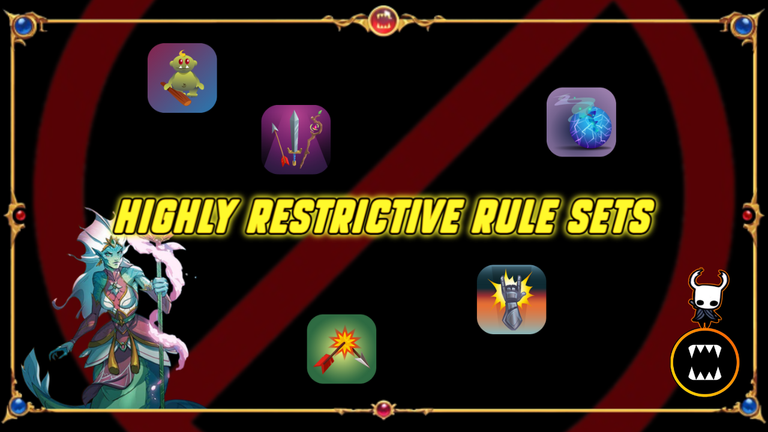
Translated by ChatGPT.
The selection of Rule Sets in Splinterlands is random, following only a few criteria to avoid rules that cancel each other out, cause ambiguous effects, etc. Considering this, it's likely that eventually you will encounter a match where the combination of 3 Rule Sets results in a huge restriction on building your team. There are many possibilities, but I'll mention some Rule Sets that alone already create a restriction—now imagine some of them combined...
Beefcakes  Broken Arrows
Broken Arrows  Even Stevens
Even Stevens 
Four's a Crowd  High Five
High Five  Going the Distance
Going the Distance 
Heavy Metal  Keep Your Distance
Keep Your Distance  Little League
Little League 
Lost Legendaries  Lost Magic
Lost Magic  Might Makes Right
Might Makes Right  Need for Speed
Need for Speed  Odd Ones Out
Odd Ones Out  Rise of the Commons
Rise of the Commons  Shades of Gray
Shades of Gray  Taking Sides
Taking Sides  Up Close and Personal
Up Close and Personal  Wands Out
Wands Out 
 Broken Arrows
Broken Arrows  Even Stevens
Even Stevens 
Four's a Crowd
 High Five
High Five  Going the Distance
Going the Distance 
Heavy Metal
 Keep Your Distance
Keep Your Distance  Little League
Little League 
Lost Legendaries
 Lost Magic
Lost Magic  Might Makes Right
Might Makes Right  Need for Speed
Need for Speed  Odd Ones Out
Odd Ones Out  Rise of the Commons
Rise of the Commons  Shades of Gray
Shades of Gray  Taking Sides
Taking Sides  Wands Out
Wands Out 
Depending on luck and your collection, you may have a tough time with some of these combinations. Therefore, it’s essential to have a highly varied collection with options that, while not often used, can be extremely useful in more restrictive situations like this. Recently, new options have arrived to broaden your range of possibilities in such situations, and I decided to test the effectiveness of this new mechanic.
In the match I’m sharing with you today, only two restrictive Rule Sets were combined, but they were already enough to give me a hard time setting up my team composition. Wands Out  and Little League
and Little League  significantly restricted my options, and I couldn’t seem to create a team that felt strong enough for the battle.
significantly restricted my options, and I couldn’t seem to create a team that felt strong enough for the battle.

Even when looking at all existing Splinterlands cards that fit within these rules, you’ll notice that there aren’t many options, and particularly few that can take on the role of Tank.

Recently, I managed to rent some Gold Foil cards from the latest edition and had few opportunities to use them. At that moment, my eyes turned to Prunda Undervesch, which seemed to be begging to be chosen. By selecting it, my range of options expanded greatly, as I could now use cards from the Life  , Water
, Water  , and Neutral
, and Neutral  elements.
elements.
Analyzing my options, I decided to create a strategy more focused on survival. Therefore, even cards like Defender of Truth, which are extremely powerful, were left out to make room for cards with buff or debuff abilities that would enhance the team’s survival. The advantage of mixing the two elements was that I could choose Divine Healer to occupy the first position. Since all cards in the backline would necessarily attack mine because of the Rule Set Target Practice  , the Healer’s cure would be enough to keep her alive throughout the match, keeping my team’s composition as intact as possible. Adding my other choices, this was the result:
, the Healer’s cure would be enough to keep her alive throughout the match, keeping my team’s composition as intact as possible. Adding my other choices, this was the result:

The idea behind this strategy was to maintain an "immortal" frontline with constant healing, while the Backline would be protected by a high-health card that could receive support from the Triage  ability. Over the course of the battle, Musa Saline could also become a great Tank, accumulating health through the Scavenger
ability. Over the course of the battle, Musa Saline could also become a great Tank, accumulating health through the Scavenger  ability.
ability.
It seems my choices were quite effective, as the enemy team had great difficulty eliminating my cards while my abilities synergistically formed a team that was both resilient and offensive. I admit that perhaps Prunda didn’t make a significant difference; after all, if I had replaced her with Alric Stormbringer, even without an absolute Tank on the frontline, doubling my team's damage would likely have sped up the opponent’s defeat. Either way, it was good to test some of the possibilities that arise with these dual-element summoners.

Thank you so much to everyone who read this far, I hope you enjoyed it. If you like my content, I ask you to send your vote on the post and follow my profile so you can read future posts.




A seleção de Rule Sets no Splinterlands é aleatória, seguindo apenas alguns critérios para evitar regras que se anulem, forneçam efeitos dúbios e etc. Considerando isso, é provavel que eventualmente você caia em uma partida onde a combinação das 3 Rule Sets resulte em uma enorme restrição para a montagem do seu time. São muitas as possibilidades, mas mencionarei algumas da Rule Sets que sozinhas já geram uma restrição, agora imagine algumas delas combinadas...
Beefcakes  Broken Arrows
Broken Arrows  Even Stevens
Even Stevens 
Four's a Crowd  High Five
High Five  Going the Distance
Going the Distance 
Heavy Metal  Keep Your Distance
Keep Your Distance  Little League
Little League 
Lost Legendaries  Lost Magic
Lost Magic  Might Makes Right
Might Makes Right  Need for Speed
Need for Speed  Odd Ones Out
Odd Ones Out  Rise of the Commons
Rise of the Commons  Shades of Gray
Shades of Gray  Taking Sides
Taking Sides  Up Close and Personal
Up Close and Personal  Wands Out
Wands Out 
 Broken Arrows
Broken Arrows  Even Stevens
Even Stevens 
Four's a Crowd
 High Five
High Five  Going the Distance
Going the Distance 
Heavy Metal
 Keep Your Distance
Keep Your Distance  Little League
Little League 
Lost Legendaries
 Lost Magic
Lost Magic  Might Makes Right
Might Makes Right  Need for Speed
Need for Speed  Odd Ones Out
Odd Ones Out  Rise of the Commons
Rise of the Commons  Shades of Gray
Shades of Gray  Taking Sides
Taking Sides  Wands Out
Wands Out 
Dependendo da sorte e da sua coleção, você passará maus bocados com algumas dessas combinações. Por isso é importante possuir uma coleção bastante variada e com opções que mesmo que não sejam muito utilizadas, eventualmente poderão ser bem úteis em situações mais restritivas como essa. Recentemente chegaram novas opções para você aumentar sua gama de possibilidades nessas situações e eu resolvi testar a eficácia dessa nova mecânica.
Na partida que compartilharei com vocês hoje, foram combinadas apenas duas Rule Sets restritivas mas que já foram suficientes para me dar grande dor de cabeça na hora de elaborar a composição do meu time. A Wands Out  e a Little League
e a Little League  restringiram bastante minhas opções e eu não estava conseguindo montar um time que parecesse forte o suficiente para a batalha.
restringiram bastante minhas opções e eu não estava conseguindo montar um time que parecesse forte o suficiente para a batalha.

Mesmo olhando todas as cartas existentes no Splinterlands que se enquadram dentro dessas regras, você perceberá que não existem tantas opções e principalmente que pouquíssimas delas conseguem assumir o papel de Tank.

Recentemente eu consegui alugar algumas cartas Gold Foil da última edição e ainda tive poucas oportunidades para utilizá-las. Foi nesse momento que meus olhos se voltaram para a Prunda Undervesch que parecia estar implorando para ser escolhida. Ao selecioná-la, meu leque de opções se abriu bastante pois agora eu poderia utilizar cartas do elemento Vida  , Água
, Água  e também as Neutras
e também as Neutras  .
.
Analisando minhas possibilidades, eu decidi que criaria uma estratégia mais focada na sobrevivência, portanto mesmo cartas como o Defender of Truth que são extremamente poderosas foram deixadas de fora para abrir espaço para cartas que teriam habilidades de buff ou debuff que favorecessem a sobrevivência do time. A vantagem de poder mesclar os dois elementos foi que pude escolher a Divine Healer para ocupar a primeira posição. Já que todas as cartas da backline obrigatoriamente atacariam a minha por causa da Rule Set Target Practice  , a cura da Healer seria suficiente para mantê-la viva durante toda a partida, mantendo a ordem da minha composição o mais intacta possível. Somando com minhas outras escolhas, esse foi o resultado:
, a cura da Healer seria suficiente para mantê-la viva durante toda a partida, mantendo a ordem da minha composição o mais intacta possível. Somando com minhas outras escolhas, esse foi o resultado:

A ideia dessa estratégia foi manter uma linha de frente "imortal" com a cura constante, enquanto a Backline seria protegida por uma carta com muita vida que poderia receber apoio da habilidade Triage  . Ao longo dos abates na partida a Musa Saline também poderia se tornar uma ótima Tank com o acúmulo de Vida advindo da habilidade Scavenger
. Ao longo dos abates na partida a Musa Saline também poderia se tornar uma ótima Tank com o acúmulo de Vida advindo da habilidade Scavenger  .
.
Parece que minhas escolhas foram bem assertivas pois o time inimigo teve muita dificuldades de eliminar minhas cartas enquanto as minhas habilidades trabalharam sinergicamente para formar um time resistente e também ofensivo. Eu admito que talvez a Prunda não tenha feito tanta diferença, afinal se a substituisse pelo Alric Stormbringer, mesmo que eu não tivesse um Tank absoluto na linha de frente, causar o dobro de dano no meu time aceleraria bastante a derrota do oponente. De qualquer forma foi bom para testar algumas das possibilidades que surgem com esses invocadores de duplo elemento.

Muito obrigado a todos que leram até aqui, espero que tenham gostado. Se vocês curtirem meus conteúdos, peço que deixem o seu voto na postagem e sigam o meu perfil para poderem acompanhar as futuras postagens.


Posted Using InLeo Alpha


